Impact of Soil Sealing on Soil Carbon Sequestration, Water Storage Potentials and Biomass Productivity in Functional Urban Areas of the European Union and the United Kingdom
Abstract
:1. Introduction
2. Method
3. Results
3.1. Sealing and Land Use Change
3.2. Sealing of Productive Lands in FUAs
3.3. Sealing and Carbon Sequestration Potential of Functional Urban Areas
3.4. Sealing and Water Holding Capacity of Functional Urban Areas
4. Discussion
5. Conclusions
Author Contributions
Funding
Institutional Review Board Statement
Informed Consent Statement
Data Availability Statement
Conflicts of Interest
Appendix A. Estimating Soil Sealing from the Urban Atlas Classes
| Urban Atlas Class Code | Urban Atlas Class Name | Estimated Sealing Share (%) |
| 11,100 | Continuous urban fabric (S.L. > 80%) | 90 |
| 11,210 | Discontinuous dense urban fabric (S.L. 50–80%) | 65 |
| 11,220 | Discontinuous medium density urban fabric (S.L. 30–50%) | 40 |
| 11,230 | Discontinuous low-density urban fabric (S.L. 10–30%) | 20 |
| 11,240 | Discontinuous very-low-density urban fabric (S.L. < 10%) | 5 |
| 11,300 | Isolated structures | 10 |
| 12,100 | Industrial, commercial, public, military and private units | 60 |
| 12,210 | Fast transit roads and associated land | 40 |
| 12,220 | Other roads and associated land | 40 |
| 12,230 | Railways and associated land | 40 |
| 12,300 | Port areas | 80 |
| 12,400 | Airports | 60 |
| 13,100 | Mineral extraction and dump sites | 10 |
| 13,300 | Construction sites | 30 |
| 13,400 | Land without current use | 5 |
| 14,100 | Green urban areas | 5 |
| 14,200 | Sports and leisure facilities | 5 |
| 21,000 | Arable land (annual crops) | 0 |
| 22,000 | Permanent crops | 0 |
| 23,000 | Pastures | 0 |
| 24,000 | Complex and mixed cultivation | 0 |
| 25,000 | Orchards | 0 |
| 31,000 | Forests | 0 |
| 32,000 | Herbaceous vegetation associations | 0 |
| 33,000 | Open spaces with little or no vegetation | 0 |
| 40,000 | Wetlands | 0 |
| 50,000 | Water | 0 |
Appendix B. Sealed Area per Urban Atlas Classes, 2018

References
- European Environment Agency (EEA). Land Take in Europe. Indicator Specification. Available online: https://www.eea.europa.eu/data-and-maps/indicators/land-take-3 (accessed on 3 May 2022).
- European Environment Agency (EEA). Urban Atlas. European Environment Agency, Copenhagen, 2012. Available online: https://land.copernicus.eu/local/urban-atlas/urban-atlas-2012 (accessed on 2 May 2022).
- McKinney, M.L. Urbanization, biodiversity, and conservation. Bioscience 2002, 52, 883–890. [Google Scholar] [CrossRef]
- Pereira, H.M.; Leadley, P.W.; Proença, V.; Alkemade, J.R.M.; Scharlemann, J.P.W.; Fernandez-Manjarres, J.F.; Araujo, M.B.; Balvanera, P.; Biggs, R.; Cheung, W.W.L.; et al. Scenarios for global biodiversity in the 21st century. Science 2010, 330, 1496–1501. [Google Scholar] [CrossRef] [PubMed] [Green Version]
- Barbero-Sierra, C.; Marques, M.J.; Ruiz-Pérez, M. The case of urban sprawl in Spain as an active and irreversible driving force for desertification. J. Arid Environ. 2013, 90, 95–102. [Google Scholar] [CrossRef]
- Charzyński, P.; Plak, A.; Hanaka, A. Influence of the soil sealing on the geoaccumulation index of heavy metals and various pollution factors. Environ. Sci. Pollut. Res. 2016, 24, 4801–4811. [Google Scholar] [CrossRef] [PubMed] [Green Version]
- Tóth, G. Impact of land-take on the land resource base for crop production in the European Union. Sci. Total Environ. 2012, 435–436, 202–214. [Google Scholar] [CrossRef]
- Naumann, S.; Frelih-Larsen, A.; Prokop, G.; Ittner, S.; Reed, M.; Mills, J.; Morari, F.; Verzandvoort, S.; Albrecht, S.; Bjuréus, A.; et al. Land Take and Soil Sealing—Drivers, Trends and Policy (Legal) Instruments: Insights from European Cities. In International Yearbook of Soil Law and Policy; Ginzky, H., Dooley, E., Heuser, I., Kasimbazi, E., Markus, T., Qin, T., Eds.; Springer: Berlin/Heidelberg, Germany, 2018; Volume 2018. [Google Scholar]
- Montanarella, L. Soil Sealing and Land Take as Global Soil Threat. The Policy Perspective. In Urban Expansion, Land Cover and Soil Ecosystem Services; Gardi, C., Ed.; Routledge: London, UK, 2017; Chapter 19; 332p. [Google Scholar]
- Dijkstra, L.; Poelman, H.; Veneri, P.; OECD. The EU-OECD Definition of a Functional Urban Area; OECD Regional Development Working Papers; OECD: Paris, France, 2019; 19p. [Google Scholar] [CrossRef]
- Concepción, E.; Obrist, M.K.; Moretti, M.; Altermatt, F.; Baur, B.; Nobis, M.P. Impacts of urban sprawl on species richness of plants, butterflies, gastropods and birds: Not only built-up area matters. Urban Ecosyst. 2016, 19, 225–242. [Google Scholar] [CrossRef]
- Gardi, C.; Panagos, P.; Van Liedekerke, M.; Bosco, C.; De Brogniez, D. Land-take and food security: Assessment of land-take on the agricultural production in Europe. J. Environ. Plan. Manag. 2014, 58, 898–912. [Google Scholar] [CrossRef]
- Fokaides, P.A.; Kylili, A.; Nicolaou, L.; Ioannou, B. The effect of soil sealing on the urban heat island phenomenon. Indoor Built Environ. 2016, 25, 1136–1147. [Google Scholar] [CrossRef]
- Murata, T.; Kawai, N. Degradation of the urban ecosystem function due to soil sealing: Involvement in the heat island phenomenon and hydrologic cycle in the Tokyo metropolitan area. Soil Sci. Plant Nutr. 2018, 64, 145–155. [Google Scholar] [CrossRef]
- Food and Agriculture Organization of the United Nations (FAO); Intergovernmental Technical Panel on Soils (ITPS). Status of the World’s Soil Resources (SWSR)—Main Report; FAO/ITPS: Rome, Italy, 2015. [Google Scholar]
- Poeplau, C.; Don, A. Carbon sequestration in agricultural soils via cultivation of cover crops—A meta-analysis. Agric. Ecosyst. Environ. 2015, 200, 33–41. [Google Scholar] [CrossRef]
- Baveye, P.C.; Otten, W.; Kravchenko, A.; Balseiro-Romero, M.; Beckers, É.; Chalhoub, M.; Darnault, C.; Eickhorst, T.; Garnier, P.; Hapca, S.; et al. Emergent Properties of Microbial Activity in Heterogeneous Soil Microenvironments: Different Research Approaches Are Slowly Converging, Yet Major Challenges Remain. Front. Microbiol. 2018, 9, 1929. [Google Scholar] [CrossRef] [PubMed]
- Van Groenigen, J.W.; van Kessel, C.; Hungate, B.A.; Oenema, O.; Powlson, D.S.; van Groenigen, K.J. Sequestering Soil Organic Carbon: A Nitrogen Dilemma. Environ. Sci. Technol. 2017, 51, 4738–4739. [Google Scholar] [CrossRef] [PubMed] [Green Version]
- Copernicus Land Monitoring Service. Urban Atlas. Available online: https://land.copernicus.eu/local/urban-atlas (accessed on 3 April 2022).
- Gregor, M.; Löhnertz, M.; Milego, R.; Fons, J.; Maucha, G.; Mancosu, E.; Littkopf, A.; Ivits, E. Time Series Inconsistency in the Copernicus HRL Imperviousness Analysis of the 2015–2018 Changes, Implications and Conclusions; ETC/ULS Technical Report 1/2021; European Topic Centre on Urban, Land and Soil Systems (ETC/ULS): Vienna, Austria; Environment Agency Austria: Vienna, Austria, 2021; 14p. [Google Scholar]
- Eurostat 2021. Database. Functional Urban Areas. Available online: https://ec.europa.eu/eurostat/web/cities/data/database (accessed on 3 April 2022).
- Maes, J.; Teller, A.; Erhard, M.; Liquete, C.; Braat, L.; Berry, P.; Egoh, B.; Puydarrieux, P.; Fiorina, C.; Santos, F.; et al. Mapping and Assessment of Ecosystems and Their Services. An Analytical Framework for Ecosystem Assessments under Action 5 of the EU Biodiversity Strategy to 2020; Publications Office of the European Union: Luxembourg, 2013. [Google Scholar]
- Ivits, E.; Milego, R.; Mancosu, E.; Gregor, M.; Petersen, J.E.; Büttner, G.; Löhnertz, M.; Maucha, G.; Petrik, O.; Bastrup-Birk, A.; et al. Environment Agency Austria, Vienna, Austria: 2020. In Land and Ecosystem Accounts for Europe. Towards Geospatial Environmental Accounting 2020; ETC/ULS Technical Report 2/2020; European Topic Centre on Urban, Land and Soil Systems (ETC/ULS): Vienna, Austria; Environment Agency Austria: Vienna, Austria, 2020; 69p. [Google Scholar]
- European Environment Agency. Data and Maps. Indicators. Vegetation Productivity. Available online: https://www.eea.europa.eu/data-and-maps/indicators/land-productivity-dynamics/assessment (accessed on 3 April 2022).
- Ivits, E.; Cherlet, M. Land-Productivity Dynamics Towards integrated assessment of land degradation at global scales. EUR 2013, 26052. [Google Scholar] [CrossRef]
- Lugato, E.; Bampa, F.; Panagos, P.; Montanarella, L.; Jones, A. Potential carbon sequestration of European arable soils estimated by modelling a comprehensive set of management practices. Glob. Chang. Biol. 2014, 20, 3557–3567. [Google Scholar] [CrossRef] [PubMed] [Green Version]
- FAO; ITPS. Global Soil Organic Carbon Map (GSOCmap) Technical Report; FAO/ITPS: Rome, Italy, 2018; 162p. [Google Scholar]
- Tóth, B.; Weynants, M.; Pásztor, L.; Hengl, T. 3D soil hydraulic database of Europe at 250 m resolution. Hydrol. Process. 2017, 31, 2662–2666. [Google Scholar] [CrossRef] [Green Version]
- EEA. Land and Soil. In The European Environment—State and Outlook 2020: Knowledge for Transition to a Sustainable Europe, European Environment Agency. 2020. Available online: https://www.eea.europa.eu/soer/publications/soer-2020 (accessed on 3 April 2022).
- Aksoy, E.; Louwagie, G.; Gardi, C.; Gregor, M.; Schröder, C.; Löhnertz, M. Assessing soil biodiversity potentials in Europe. Sci. Total Environ. 2017, 589, 236–249. [Google Scholar] [CrossRef] [PubMed]
- Wardle, D.A. Do experiments exploring plant diversity—Ecosystem functioning relationships inform how biodiversity loss impacts natural ecosystems? J. Veg. Sci. 2016, 27, 646–653. [Google Scholar] [CrossRef]
- Wu, A.P.; Ye, S.Y.; Yuan, J.R.; Qi, L.Y.; Cai, Z.W.; Ye, B.B.; Wang, Y.H. The relationship between diversity and productivity from a three-dimensional space view in a natural mesotrophic lake. Ecol. Indic. 2021, 121, 107069. [Google Scholar] [CrossRef]
- Luo, W.; Liang, J.; Cazzolla, G.R.; Zhao, X.; Zhang, C. Parameterization of biodiversity-productivity relationship and its scale dependency using georeferenced tree-level data. J. Ecol. 2019, 107, 1106–1119. [Google Scholar] [CrossRef]
- Yao, J.; Kong, X. Modeling the effects of land-use optimization on the soil organic carbon sequestration potential. J. Geogr. Sci. 2018, 28, 1641–1658. [Google Scholar] [CrossRef] [Green Version]
- Hagedorn, F.; Maurer, S.; Egli, P.; Blaser, P.; Bucher, J.B.; Siegwolf, R. Carbon sequestration in forest soils: Effects of soil type, atmospheric CO2 enrichment, and N deposition. Eur. J. Soil Sci. 2001, 52, 619–628. [Google Scholar] [CrossRef]
- Vågen, T.-G.; Lal, R.; Singh, B.R. Soil carbon sequestration in sub-Saharan Africa: A review. Land Degrad. Dev. 2005, 16, 53–71. [Google Scholar] [CrossRef]
- Lal, R. Digging deeper: A holistic perspective of factors affecting soil organic carbon sequestration in agroecosystems. Glob. Chang. Biol. 2018, 24, 3285–3301. [Google Scholar] [CrossRef] [PubMed]
- Davidson, E.; Janssens, I. Temperature sensitivity of soil carbon decomposition and feedbacks to climate change. Nature 2006, 440, 165–173. [Google Scholar] [CrossRef] [PubMed]
- Pistocchi, A. Hydrological Impacts of Soil Sealing and Urban Land Take. In Urban Expansion, Land Cover and Soil Ecosystem Services; Routledge: London, UK; Taylor & Francis Group: New York, NY, USA, 2017. [Google Scholar]
- Rahman, A.; Khan, A.; Haq, N.; Samiullah, S.R. Soil Sealing and Depletion of Groundwater in Rapidly Growing Peshawar City District Pakistan. In Urban Drought. Disaster Risk Reduction; Ray, B., Shaw, R., Eds.; Springer: Singapore, 2019; pp. 289–309. [Google Scholar]
- Pistocchi, A.; Calzolari, C.; Malucelli, F.; Ungaro, F. Soil sealing and flood risks in the plains of Emilia-Romagna, Italy. J. Hydrol. Reg. Stud. 2015, 4(Part B), 398–409. [Google Scholar] [CrossRef]
- Recanatesi, F.; Petroselli, A. Land Cover Change and Flood Risk in a Peri-Urban Environment of the Metropolitan Area of Rome (Italy). Water Resour. Manag. 2020, 34, 4399–4413. [Google Scholar] [CrossRef]
- Artmann, M. Managing urban soil sealing in Munich and Leipzig (Germany)—From a wicked problem to clumsy solutions. Land Use Policy 2015, 46, 21–37. [Google Scholar] [CrossRef]
- Tardieu, L.; Hamel, P.; Viguié, V.; Coste, L.; Levrel, H. Are soil sealing indicators sufficient to guide urban planning? Insights from an ecosystem services assessment in the Paris metropolitan area. Environ. Res. Lett. 2021, 16, 1–14. [Google Scholar] [CrossRef]
- Artmann, M. Urban gray vs. urban green vs. soil protection—Development of a systemic solution to soil sealing management on the example of Germany. Environ. Impact Assess. Rev. 2016, 59, 27–42. [Google Scholar] [CrossRef]
- Gosnell, H.; Kline, J.D.; Chrostek, G.; Duncan, J. Is Oregon’s land use planning program conserving forest and farm land? A review of the evidence. Land Use Policy 2011, 28, 185–192. [Google Scholar] [CrossRef]
- Tobias, S.; Conen, F.; Duss, A.; Wenzel, L.M.; Buser, C.; Alewell, C. Soil sealing and unsealing: State of the art and examples. Land Degrad. Dev. 2018, 29, 2015–2024. [Google Scholar] [CrossRef]
- Burian, S.J.; Pomeroy, C.A. Urban Impacts on the Water Cycle and Potential Green Infrastructure Implications. In Urban Ecosystem Ecology. Agronomy Monograph; Aitkenhead Peterson, J., Volder, A., Eds.; American Society of Agronomy, Crop Science Society of America, Soil Science Society of America: Madison, WI, USA, 2010; Volume 55. [Google Scholar]
- Minixhofer, P.; Stangl, R. Green Infrastructures and the Consideration of Their Soil-Related Ecosystem Services in Urban Areas—A Systematic Literature Review. Sustainability 2021, 13, 3322. [Google Scholar] [CrossRef]
- EEA. Imperviousness Density 2018. Available online: https://land.copernicus.eu/pan-european/high-resolution-layers/imperviousness/status-maps/imperviousness-density-2018 (accessed on 2 May 2022).

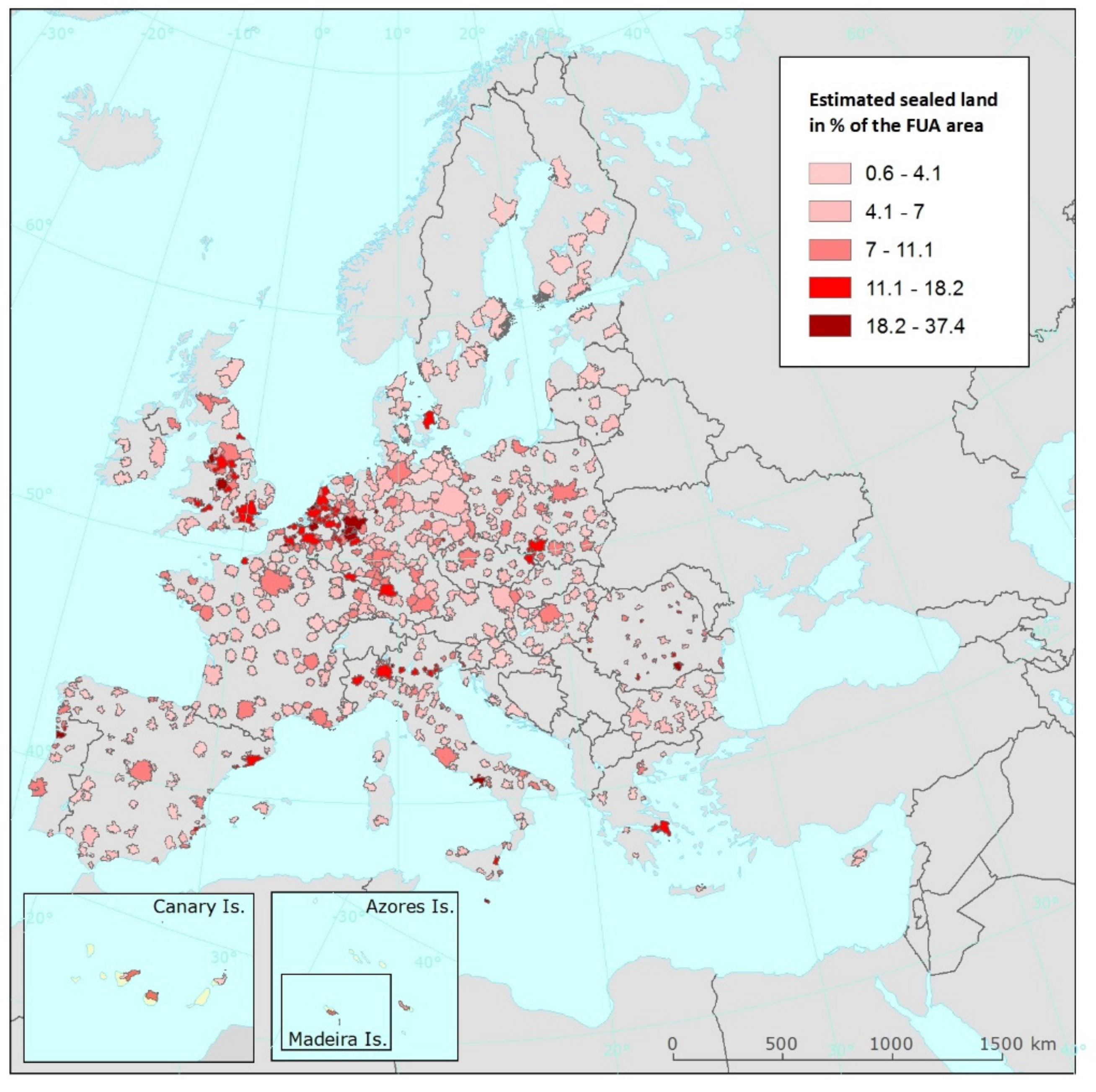
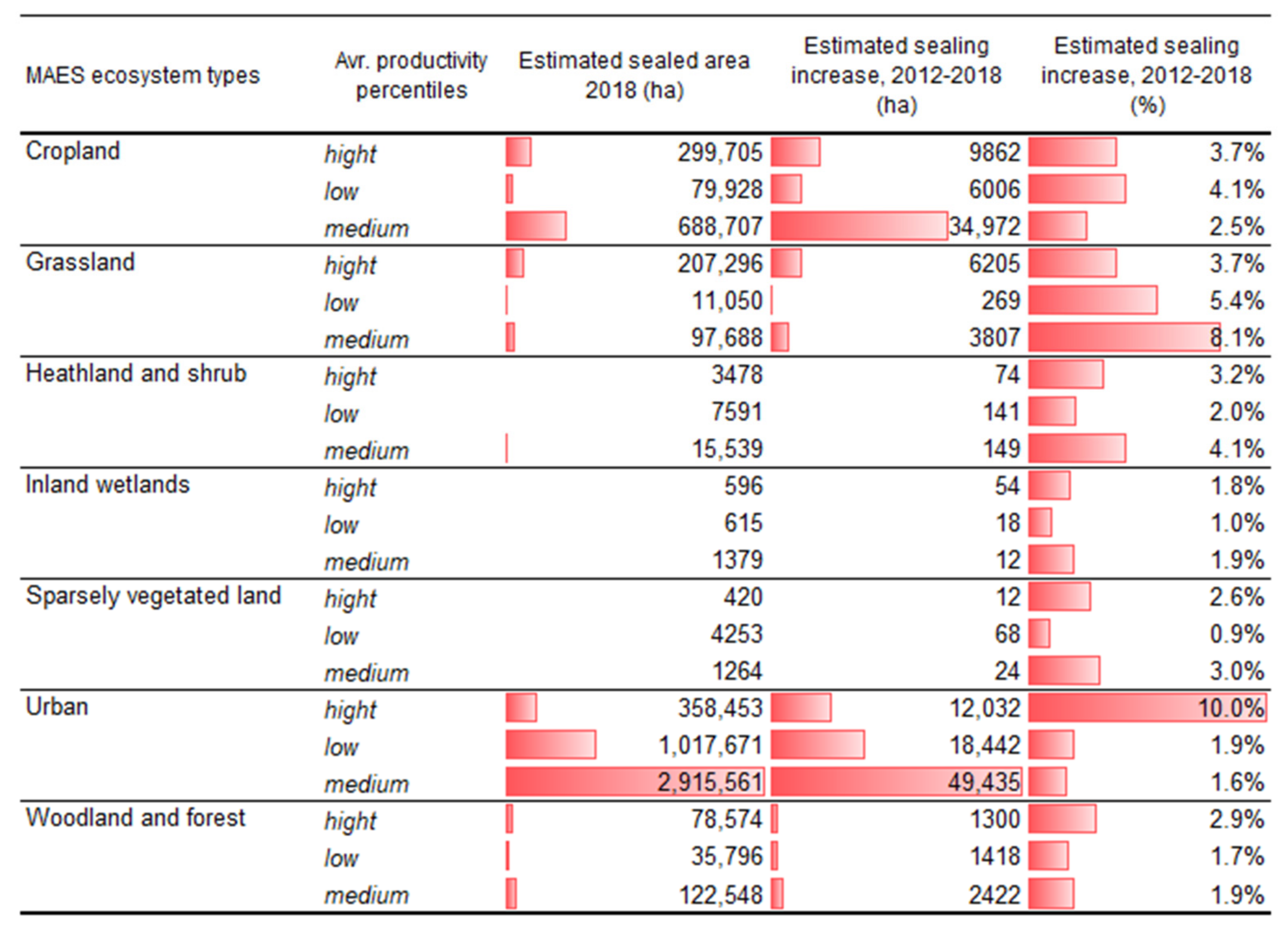

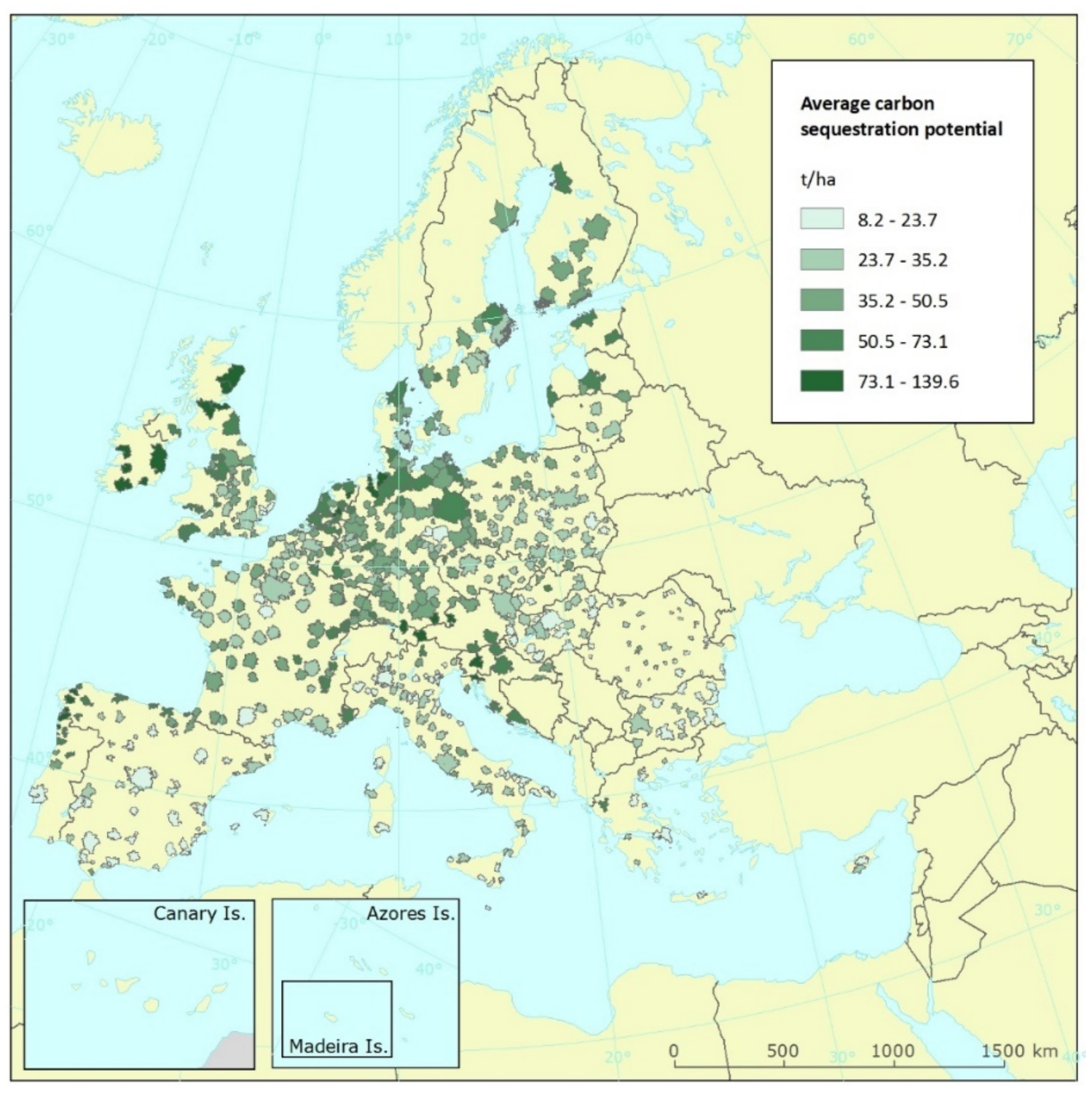

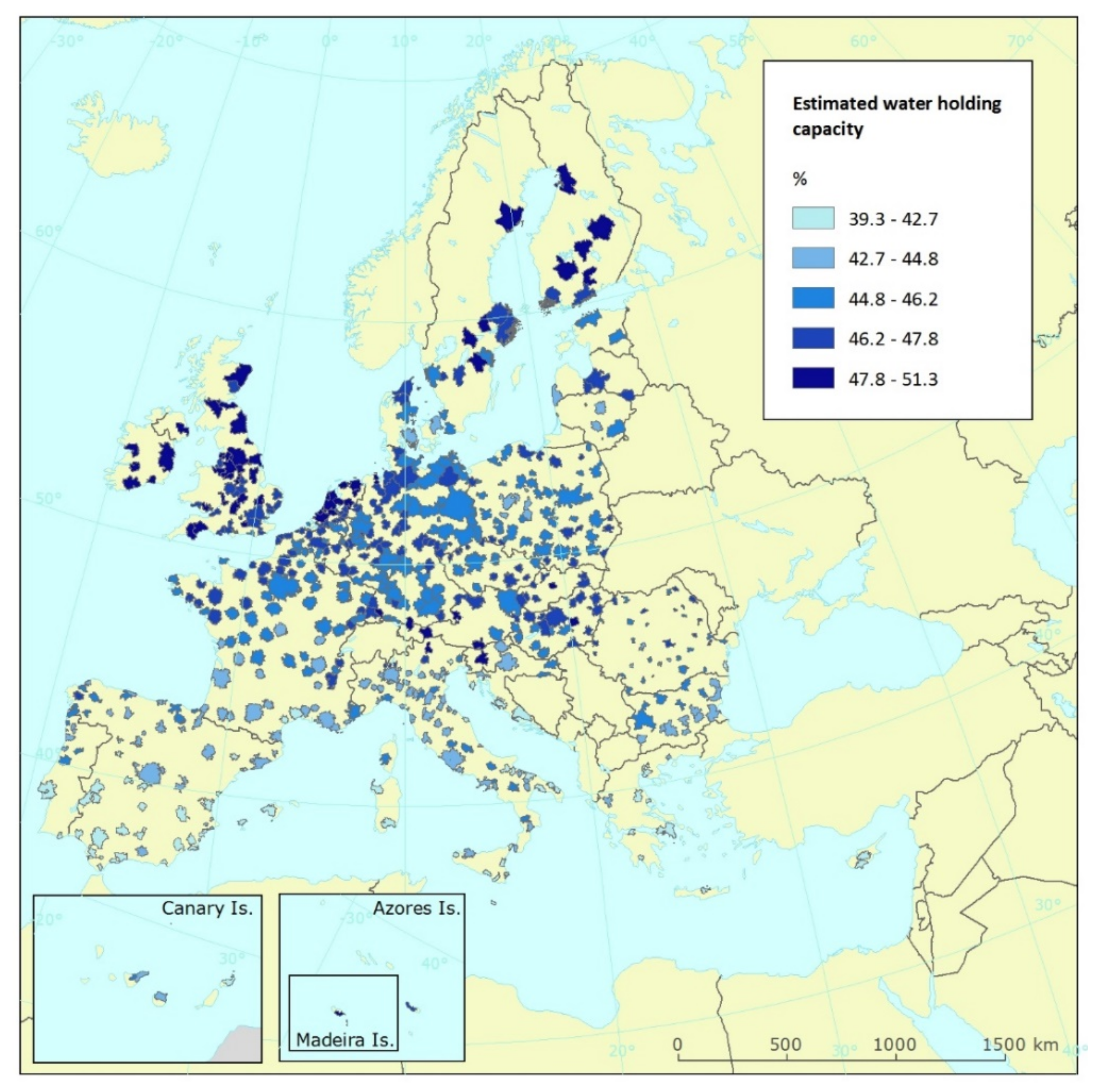
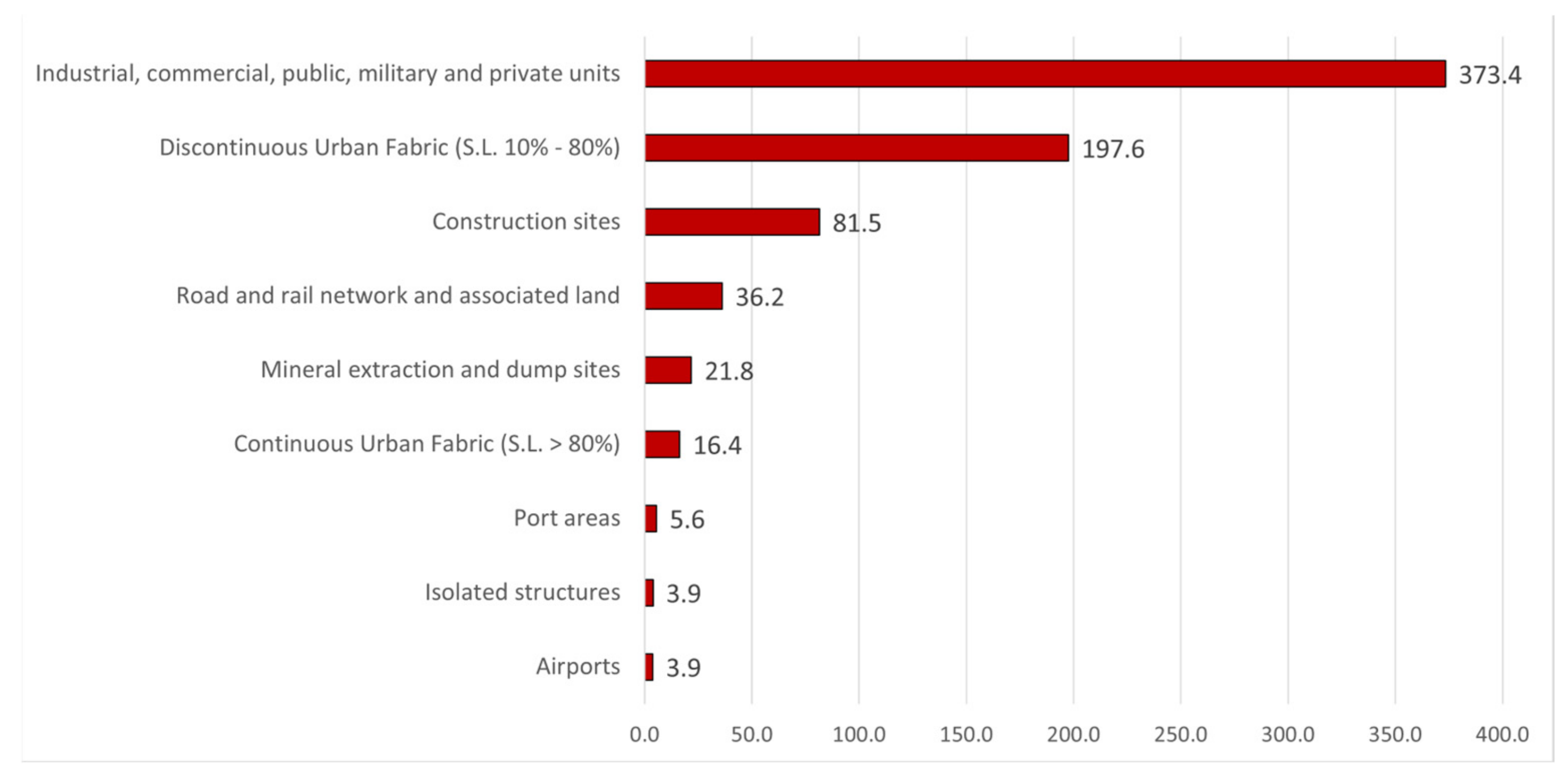
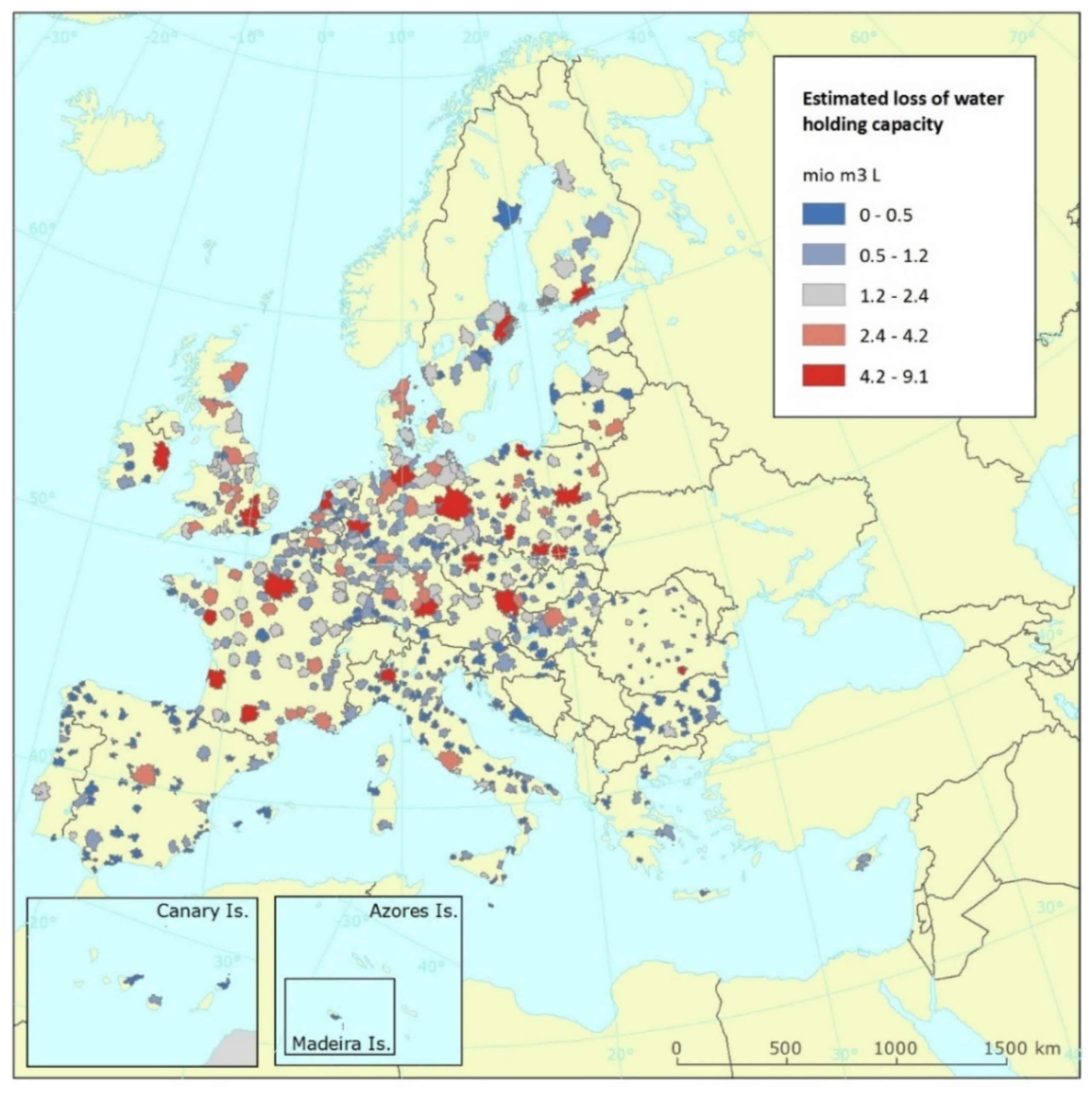
Publisher’s Note: MDPI stays neutral with regard to jurisdictional claims in published maps and institutional affiliations. |
© 2022 by the authors. Licensee MDPI, Basel, Switzerland. This article is an open access article distributed under the terms and conditions of the Creative Commons Attribution (CC BY) license (https://creativecommons.org/licenses/by/4.0/).
Share and Cite
Tóth, G.; Ivits, E.; Prokop, G.; Gregor, M.; Fons-Esteve, J.; Milego Agràs, R.; Mancosu, E. Impact of Soil Sealing on Soil Carbon Sequestration, Water Storage Potentials and Biomass Productivity in Functional Urban Areas of the European Union and the United Kingdom. Land 2022, 11, 840. https://doi.org/10.3390/land11060840
Tóth G, Ivits E, Prokop G, Gregor M, Fons-Esteve J, Milego Agràs R, Mancosu E. Impact of Soil Sealing on Soil Carbon Sequestration, Water Storage Potentials and Biomass Productivity in Functional Urban Areas of the European Union and the United Kingdom. Land. 2022; 11(6):840. https://doi.org/10.3390/land11060840
Chicago/Turabian StyleTóth, Gergely, Eva Ivits, Gundula Prokop, Mirko Gregor, Jaume Fons-Esteve, Roger Milego Agràs, and Emanuele Mancosu. 2022. "Impact of Soil Sealing on Soil Carbon Sequestration, Water Storage Potentials and Biomass Productivity in Functional Urban Areas of the European Union and the United Kingdom" Land 11, no. 6: 840. https://doi.org/10.3390/land11060840
APA StyleTóth, G., Ivits, E., Prokop, G., Gregor, M., Fons-Esteve, J., Milego Agràs, R., & Mancosu, E. (2022). Impact of Soil Sealing on Soil Carbon Sequestration, Water Storage Potentials and Biomass Productivity in Functional Urban Areas of the European Union and the United Kingdom. Land, 11(6), 840. https://doi.org/10.3390/land11060840







